





How many expanding garden projects start with the thought, ?well, as long as I?m digging, I may as well?? Before you know it, a new little ?corner garden? has taken over half your back yard. When it comes to planting spring-blooming daffodils, however, you can get twice the flower power without any more actual digging by planting smaller companion bulbs at the same time.
We've all heard the admonition to "measure twice, cut once." I have my own rule of thumb for planting bulbs in fall: Dig once, plant twice! I love daffodils, but I never plant them alone. If I'm going to dig a hole for bulbs, I want maximum results for my efforts, so daffodils and companion bulbs get planted together. Always.
In general, bulbs should be planted at a depth equal to 2 to 3 times their diameter. For daffodil bulbs, that generally means digging a hole 4 to 6 inches deep. 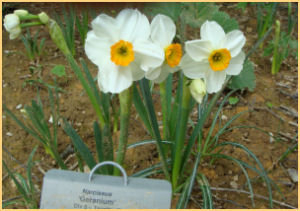 I like to plant bulbs in clumps. I think clumps of daffodils create a more natural, "naturalized" look than scattered single bulbs. It's also much quicker to plant 100 daffodil bulbs by shoveling out a dozen holes for clumps of bulbs than by digging 100 little individual holes with a bulb planter.
I like to plant bulbs in clumps. I think clumps of daffodils create a more natural, "naturalized" look than scattered single bulbs. It's also much quicker to plant 100 daffodil bulbs by shoveling out a dozen holes for clumps of bulbs than by digging 100 little individual holes with a bulb planter.
I like to dig holes a foot or so across that can hold 5 or 7 bulbs, placed 4 or 5 inches apart. For a natural, "naturalized" look, avoid straight lines and squared-off groupings of bulbs. Circular clumps will work, but I like the look of "blobular" shapes. A handful of bulb food scattered in the hole will get your new purchases off to a good start. My grandmother, who was an artist, always said that everything looks better placed in odd numbers. So, I plant clumps of 3 or 7 bulbs rather than 2 or 8.
After you've placed the 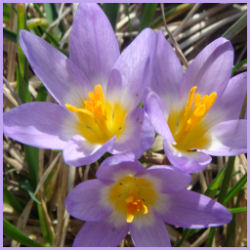 daffodil bulbs in the hole and filled it halfway with soil, you'll have a hole of the perfect depth for planting smaller bulbs around and between them. Think about the effect you'd like to create, in terms of both color and bloom time.
daffodil bulbs in the hole and filled it halfway with soil, you'll have a hole of the perfect depth for planting smaller bulbs around and between them. Think about the effect you'd like to create, in terms of both color and bloom time.
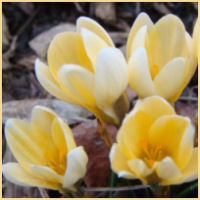 For an earlier show of color, when the tips of the daffodil leaves have barely begun to emerge, plant handfuls of crocus bulbs around and between the lower daffodil bulbs. Snow crocus (Crocus chrysanthus), "tommies" (C. tommasinianus), and C. sieberi are the earliest bloomers, followed by the larger Dutch or Giant Crocus, C. vernus. The blooming daffodils will hide the fading crocus foliage, for a lovely succession of spring color.
For an earlier show of color, when the tips of the daffodil leaves have barely begun to emerge, plant handfuls of crocus bulbs around and between the lower daffodil bulbs. Snow crocus (Crocus chrysanthus), "tommies" (C. tommasinianus), and C. sieberi are the earliest bloomers, followed by the larger Dutch or Giant Crocus, C. vernus. The blooming daffodils will hide the fading crocus foliage, for a lovely succession of spring color.
There's an assortment of "little blue bulbs" to choose from that are wonderful accents for yellow and white daffodils. Some people scatter companion bulbs among the daffodil blooms. I like to plant little bulbs in "sweeps" so their color is a less subtle accent. 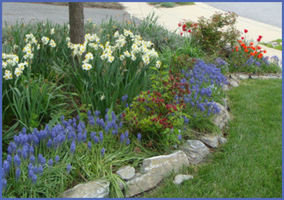 The "river" of grape hyacinths running between banks of 'Thalia' daffodils is a landmark at the Keukenhof's famous spring display. A much smaller "streamlet" of grape hyacinths curves along the border of my front landscape bed, setting off the 'Geranium' and 'Replete' daffodils there.
The "river" of grape hyacinths running between banks of 'Thalia' daffodils is a landmark at the Keukenhof's famous spring display. A much smaller "streamlet" of grape hyacinths curves along the border of my front landscape bed, setting off the 'Geranium' and 'Replete' daffodils there.
Pay attention to bloom times when choosing companion bulbs. 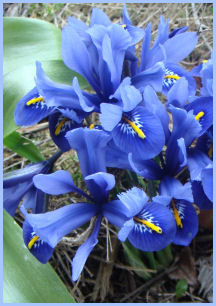 Grape hyacinths (Muscari armeniacum) and species tulips generally bloom with mid to late season daffodils, while Scilla, Iris reticulata, and windflowers (Anemone blanda) will bloom with earlier daffodils. Planting multiple varieties of both daffodils and companions for extended bloom times will ensure that you'll have great color combinations each year.
Grape hyacinths (Muscari armeniacum) and species tulips generally bloom with mid to late season daffodils, while Scilla, Iris reticulata, and windflowers (Anemone blanda) will bloom with earlier daffodils. Planting multiple varieties of both daffodils and companions for extended bloom times will ensure that you'll have great color combinations each year.
In addition to other bulbs, consider other perennials as daffodil companions. Last fall, I planted a few handfuls of miniature daffodil bulbs around my dwarf irises. 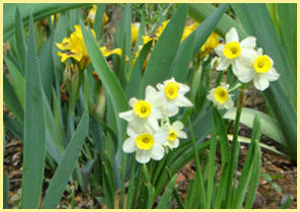 I love the combination of the delicate daffodil bells with the bolder blooms and foliage of the irises. I don't know if their timing will be the same next year, but I hope so! Daffodils are good to plant with spring blooming perennials, and they are also great companions for late-emerging perennials such as daylilies, bronze fennel, and peonies. They take turns and play nicely with others. First, the daffodils emerge and put on a show. As the daffodil foliage starts dying back, the summer perennials take over.
I love the combination of the delicate daffodil bells with the bolder blooms and foliage of the irises. I don't know if their timing will be the same next year, but I hope so! Daffodils are good to plant with spring blooming perennials, and they are also great companions for late-emerging perennials such as daylilies, bronze fennel, and peonies. They take turns and play nicely with others. First, the daffodils emerge and put on a show. As the daffodil foliage starts dying back, the summer perennials take over.
Some shrubs are especially good companions for spring blooming bulbs, also. The blooms of Azaleas, Forsythia, Japonica, and Lilacs complement or echo the colors of daffodils and other spring blooming bulbs.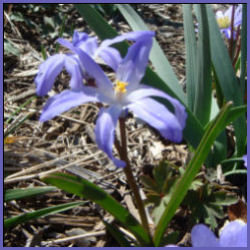 I have a dwarf ‘Ramopo' rhododendron by my front entrance that blooms at exactly the same time as some nearby ‘Tete a Tete' miniature daffodils. With several different daffodils and a variety of "little blue bulbs" in our front garden, there's always something flowering when the azalea bushes burst into bloom.
I have a dwarf ‘Ramopo' rhododendron by my front entrance that blooms at exactly the same time as some nearby ‘Tete a Tete' miniature daffodils. With several different daffodils and a variety of "little blue bulbs" in our front garden, there's always something flowering when the azalea bushes burst into bloom.
 Whether you're ordering daffodil bulbs or perennial plants for fall planting this year, make your digging do double duty. Purchase some little companion bulbs to plant around and between whatever else you're planting. Next spring, you'll be rewarded with extra splashes of color all over your garden!
Whether you're ordering daffodil bulbs or perennial plants for fall planting this year, make your digging do double duty. Purchase some little companion bulbs to plant around and between whatever else you're planting. Next spring, you'll be rewarded with extra splashes of color all over your garden!
For more about planting daffodils, see this DG article on Daffodils by Gloria Cole. Also look for Todd Boland's articles on many of the "little blue flowers" mentioned here.
Photos by Jill M. Nicolaus. Move your mouse over the photos for image info.
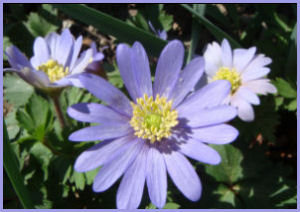 (Editor's Note: This article was originally published on September 18, 2008. Your comments are welcome, but please be aware that authors of previously published articles may not be able to promptly respond to new questions or comments.)
(Editor's Note: This article was originally published on September 18, 2008. Your comments are welcome, but please be aware that authors of previously published articles may not be able to promptly respond to new questions or comments.)
Copyright © www.100flowers.win Botanic Garden All Rights Reserved